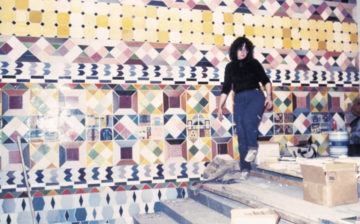Lynne Cooke at Artforum:
 IN AN APPRECIATIVE 2016 REVIEW of new work by Valerie Jaudon, critic David Frankel noted that the Pattern and Decoration movement, of which Jaudon was a prominent member, had long been held in disrepute. “In the early ’80s,” Frankel wrote, “I remember a colleague at Artforum at the time saying it could never be taken seriously in the magazine.”1 In retrospect, what makes this dismissal so striking is that, in the mid-’70s, Artforum contributed significantly to P&D’s emergence into the spotlight, publishing key texts by its advocates along with numerous reviews of its shows. Amy Goldin’s “Patterns, Grids, and Painting” (1975) and Jeff Perrone’s “Approaching the Decorative” (1976) were among the early touchstones for P&D’s heterogeneous cohort, riled by the unmitigated critical support for diverse ascetic and masculinist tendencies pervasive in the painting of the moment. However, by the mid-’80s, eclipsed by newer developments—the Pictures generation, neo-geo, et al.—P&D was increasingly coming under fire for positions now considered controversial: for the purported essentialism of its versions of second-wave feminism, for a naive advocacy that masked acts of Orientalizing and primitivizing, for cultural imperialism. More fundamental “problems” largely went unnoted, including a lack of the kind of conceptual depth expected of cutting-edge practices: In their commitment to the decorative, P&D artists prioritized surface over subject matter, the former serving primarily as a vehicle for sensuous effects. Not least, the art world’s entrenched sexism fostered the occasion for its denizens to belittle and sideline a movement renowned for the dominant role played by women in its genesis and trajectory.
IN AN APPRECIATIVE 2016 REVIEW of new work by Valerie Jaudon, critic David Frankel noted that the Pattern and Decoration movement, of which Jaudon was a prominent member, had long been held in disrepute. “In the early ’80s,” Frankel wrote, “I remember a colleague at Artforum at the time saying it could never be taken seriously in the magazine.”1 In retrospect, what makes this dismissal so striking is that, in the mid-’70s, Artforum contributed significantly to P&D’s emergence into the spotlight, publishing key texts by its advocates along with numerous reviews of its shows. Amy Goldin’s “Patterns, Grids, and Painting” (1975) and Jeff Perrone’s “Approaching the Decorative” (1976) were among the early touchstones for P&D’s heterogeneous cohort, riled by the unmitigated critical support for diverse ascetic and masculinist tendencies pervasive in the painting of the moment. However, by the mid-’80s, eclipsed by newer developments—the Pictures generation, neo-geo, et al.—P&D was increasingly coming under fire for positions now considered controversial: for the purported essentialism of its versions of second-wave feminism, for a naive advocacy that masked acts of Orientalizing and primitivizing, for cultural imperialism. More fundamental “problems” largely went unnoted, including a lack of the kind of conceptual depth expected of cutting-edge practices: In their commitment to the decorative, P&D artists prioritized surface over subject matter, the former serving primarily as a vehicle for sensuous effects. Not least, the art world’s entrenched sexism fostered the occasion for its denizens to belittle and sideline a movement renowned for the dominant role played by women in its genesis and trajectory.
more here.
